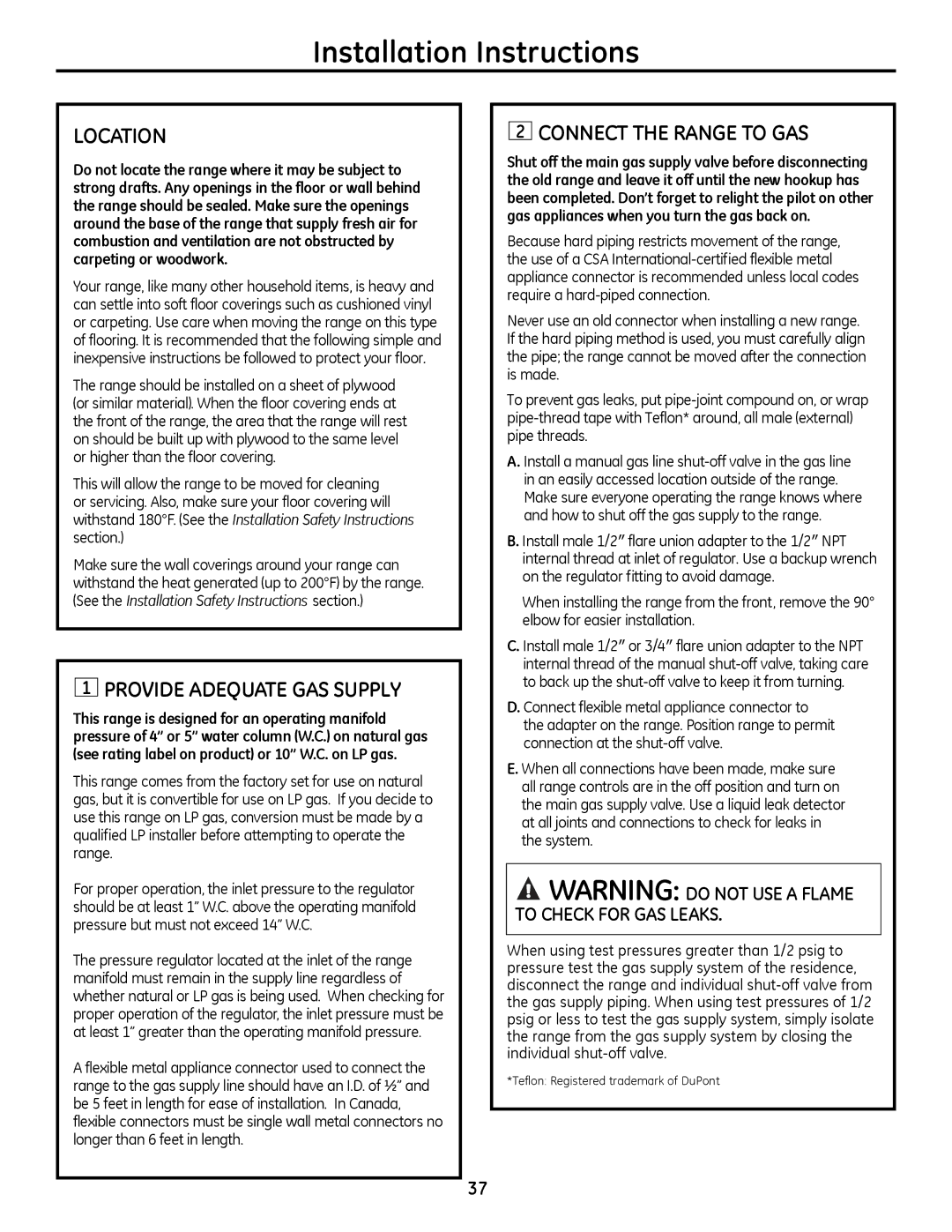
Installation Instructions
LoCATIoN
Do not locate the range where it may be subject to strong drafts. Any openings in the floor or wall behind the range should be sealed. Make sure the openings around the base of the range that supply fresh air for combustion and ventilation are not obstructed by carpeting or woodwork.
Your range, like many other household items, is heavy and can settle into soft floor coverings such as cushioned vinyl or carpeting. Use care when moving the range on this type of flooring. It is recommended that the following simple and inexpensive instructions be followed to protect your floor.
The range should be installed on a sheet of plywood (or similar material). When the floor covering ends at the front of the range, the area that the range will rest on should be built up with plywood to the same level or higher than the floor covering.
This will allow the range to be moved for cleaning or servicing. Also, make sure your floor covering will withstand 180°F. (See the Installation Safety Instructions section.)
Make sure the wall coverings around your range can withstand the heat generated (up to 200°F) by the range. (See the Installation Safety Instructions section.)
1PRoVIDE ADEqUATE GAS SUPPLy
This range is designed for an operating manifold pressure of 4” or 5” water column (w.C.) on natural gas (see rating label on product) or 10” w.C. on LP gas.
This range comes from the factory set for use on natural gas, but it is convertible for use on LP gas. If you decide to use this range on LP gas, conversion must be made by a qualified LP installer before attempting to operate the range.
For proper operation, the inlet pressure to the regulator should be at least 1” W.C. above the operating manifold pressure but must not exceed 14” W.C.
The pressure regulator located at the inlet of the range manifold must remain in the supply line regardless of whether natural or LP gas is being used. When checking for proper operation of the regulator, the inlet pressure must be at least 1” greater than the operating manifold pressure.
A flexible metal appliance connector used to connect the range to the gas supply line should have an I.D. of ½” and be 5 feet in length for ease of installation. In Canada, flexible connectors must be single wall metal connectors no longer than 6 feet in length.
2CoNNECT THE RANGE To GAS
Shut off the main gas supply valve before disconnecting the old range and leave it off until the new hookup has been completed. Don’t forget to relight the pilot on other gas appliances when you turn the gas back on.
Because hard piping restricts movement of the range, the use of a CSA
Never use an old connector when installing a new range. If the hard piping method is used, you must carefully align the pipe; the range cannot be moved after the connection is made.
To prevent gas leaks, put
A. Install a manual gas line
B. Install male 1/2″ flare union adapter to the 1/2″ NPT internal thread at inlet of regulator. Use a backup wrench on the regulator fitting to avoid damage.
B. When installing the range from the front, remove the 90° elbow for easier installation.
C. Install male 1/2″ or 3/4″ flare union adapter to the NPT internal thread of the manual
D. Connect flexible metal appliance connector to the adapter on the range. Position range to permit connection at the
E. When all connections have been made, make sure all range controls are in the off position and turn on the main gas supply valve. Use a liquid leak detector at all joints and connections to check for leaks in the system.
![]()
![]() wARNING: Do NoT USE A FLAME To CHECK FoR GAS LEAKS.
wARNING: Do NoT USE A FLAME To CHECK FoR GAS LEAKS.
When using test pressures greater than 1/2 psig to pressure test the gas supply system of the residence, disconnect the range and individual
*Teflon: Registered trademark of DuPont
37
